a&e features
Out actor Michael Urie savors sleek, timely ‘Hamlet’ production
New York-based star is former student of D.C. theater titan Michael Kahn
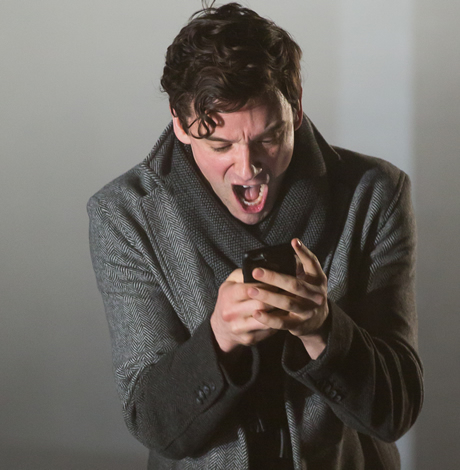

Michael Urie used to rehearse scenes from ‘Hamlet’ just for fun before being cast in the Michael Kahn production. (Photo by Scott Suchman; courtesy STC)
‘Hamlet’
Through March 4
Shakespeare Theatre Company
Sidney Harman Hall
610 F Street, NW
$44-125
202-547-1122
At 37, Michael Urie has the acting career that he couldn’t imagine as a kid in Plano, Texas.
“I thought maybe I’d be a drama teacher one day but couldn’t see much beyond that. And then I moved to New York City where I felt both instantly at home and inspired by the possibility that I could be a real, working actor.”
Today, Urie’s vast and varied vitae includes classical theater, Broadway musicals, 600 performances of “Buyer and Cellar” (his one-man comedy about a young manager of a mock mall on Barbra Streisand’s Malibu estate) and a successful run on TV’s “Ugly Betty.”
Last week, the approachable actor sat down at an out-of-the-way coffeeshop in Chinatown for tea and some talk about tackling a theatrical milestone. It was like meeting with a fun acquaintance who just happens to know a lot about Shakespeare.
When Shakespeare Theatre Company’s Michael Kahn was asked to do one more play from the bard’s canon before ending his tenure as artistic director, he agreed to stage his third “Hamlet” provided Urie play the title role. As Hamlet, Urie, who studied drama with Kahn at Juilliard School in New York, brings a mix of dramatic and comic talents to the story of the Danish prince whose life is rocked after his uncle murders his father the king, marries his mother and steals the crown. Set in a contemporary, sleek police state, the production certainly resonates.
WASHINGTON BLADE: When Michael Kahn offered you Hamlet, how’d you react?
MICHAEL URIE: I accepted without hesitation of course. It’s a part I’ve wanted to play forever. In the past I’d get studio space and work on it from time to time with another director. We’d bring in other actors and do the ghost scene or the Gertrude scene just for ourselves.
BLADE: Is that a thing actors do?
URIE: Nerds like me, yeah. Coming in, I knew the text. I had played Hamlet’s friend Horatio at South Coast Repertory in California. And I did Hamlet’s “To be, or not to be” soliloquy in Michael Kahn’s class at Juilliard. Jessica Chastain (then-fellow acting student and now movie star) was my Ophelia.
BLADE: Are you into the politics of the play?
URIE: How could you not be? The politics of Shakespeare are as universal and timeless as the way he discusses sanity, love and all the other timeless things you find in his works. The whisper campaign sensibility of our production feels very at home here in Washington. … Referring to the death of his father and his uncle’s shady ascension to the throne, Hamlet says, “But two months dead — nay, not so much, not two. So excellent a king, that was to this Hyperion to a satyr.” Similarly, in real life, we’ve gone from the best possible example of what an American can be to the worst of all likelihoods. I have a great sense of pride that there’s a production of “Hamlet” happening in the nation’s capital the week that the Obamas’ portraits are unveiled and the week that the FBI says the White House is lying. And here I am doing a play about spying and lying.
BLADE: How are D.C. audiences?
URIE: When New York audiences embrace you, it’s very exciting. There’s nothing like it. On the other hand, many of them are career theatergoers, and along with their love of theater is a need to qualify what they’re seeing. They’re inherently all critics. Washington audiences are smart. And with the exception of the critics, I find that audiences are coming to enjoy themselves. They’re not seeing shows four times a week like some New York theatergoers. They’re going once or twice a month. They’re coming to find what they like and not what they don’t like about a show. When I was at the Shakespeare Theatre doing “Buyer & Cellar” a few years ago, my costumer told me a story about three fratty young slightly drunk young guys on the Metro looking at my poster. One of them said, “Look at this! Look at this! See this guy.” And my costumer leaned in to hear what he’d say. “This guy plays a bunch of parts all by himself and he’s awesome. We gotta go.” Their counterparts in New York wouldn’t have even noticed the poster.
BLADE: “Hamlet’s” cast includes your partner of nine years Ryan Spahn, who also studied under Kahn. As Hamlet’s former school pal Rosencrantz, Ryan moves admirably from comic to sinister.
URIE: He is good, isn’t he? Rosencrantz and Guildenstern are such complicated characters. Lots of people feel like Hamlet isn’t justified in the sending his old schoolmates to their deaths. In this production they’re all in with the king and they stand by and watch Hamlet beaten by the guards.
BLADE: A former sitcom star once told me that nothing compares to TV fame. It’s explosive. People who never see a movie or go to the theater watch TV. Was that your experience, and would you do TV again?
URIE: Yes and yes. After “Ugly Betty” was cancelled I did 13 episodes of “Partners,” a CBS sitcom about gay friends from the guys who made “Will & Grace.” Out of the gate we were a hit. After just three months we won a Golden Globe. That never happens. Yet after our ratings dipped, the show was cancelled. We had more stories to tell and our numbers weren’t bad.
BLADE: Was that difficult?
URIE: Yes, but not as hard as when “Ugly Betty” ended. We were a family for four years. Actors rarely have jobs that last that long.
BLADE: Hamlet changes a lot over the play. You make those changes feel real.
URIE: Thanks. It’s true that he can go from horribly depressed to giddy. He’s wildly emotional, wickedly smart and follows his impulses. Hamlet is probably bipolar. He’s always smart but by the end of the play, he has evolved. He has come to terms with mortality and his place in the world. He finds humility and grace.
BLADE: And do you relate to that?
URIE: In the last two years I’ve noticed a change in myself. Not too long ago I was at a rehearsal where I was the oldest person in the room. People looked at me to set the tone. It was different but I liked it. You don’t feel like you have to prove something or try to be liked. My three most recent works — “General Inspector,” Harvey Fierstein’s “Torch Song” and now “Hamlet” — have all been very formative. “General Inspector” was a silly comedy with a big cast. I was the lead but it was collaborative in the sense that I’ll help you get your laughs if you help me get mine. “Torch Song” is a great American story, a beautiful revival that means so much to people. “Hamlet” is a combination of both of those things. I really think everything leading up till today has informed what I’m doing now.
BLADE: Hamlet can seem so ineffective at times, but that’s not you.
URIE: I certainly have never been one to let grass grow under my feet. But that’s the nature of being an actor. You have to keep moving and looking for work all the time.
BLADE: Would you play Hamlet again?
URIE: I never say never. But for a Juilliard-trained actor who embraced the training and sought a career in theater, this production has been the way to do it. I’m so intensely satisfied with our cast and the way Michael Kahn has led me through the role. And the audience’s response has been amazing.
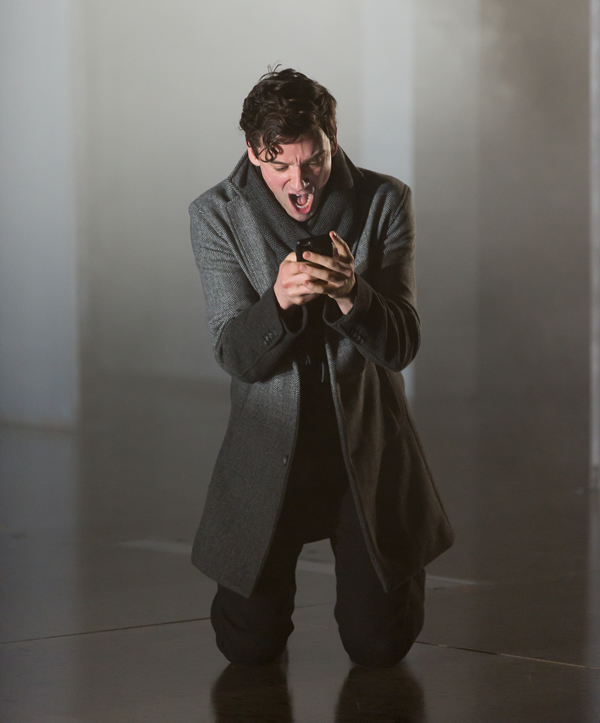
Michael Urie says the sleek, modern ‘Hamlet’ he’s currently in has pertinence to present-day Washington. (Photo by Scott Suchman; courtesy STC)
a&e features
Visit Cambridge, a ‘beautiful secret’ on Maryland’s Eastern Shore
New organization promotes town’s welcoming vibe, LGBTQ inclusion
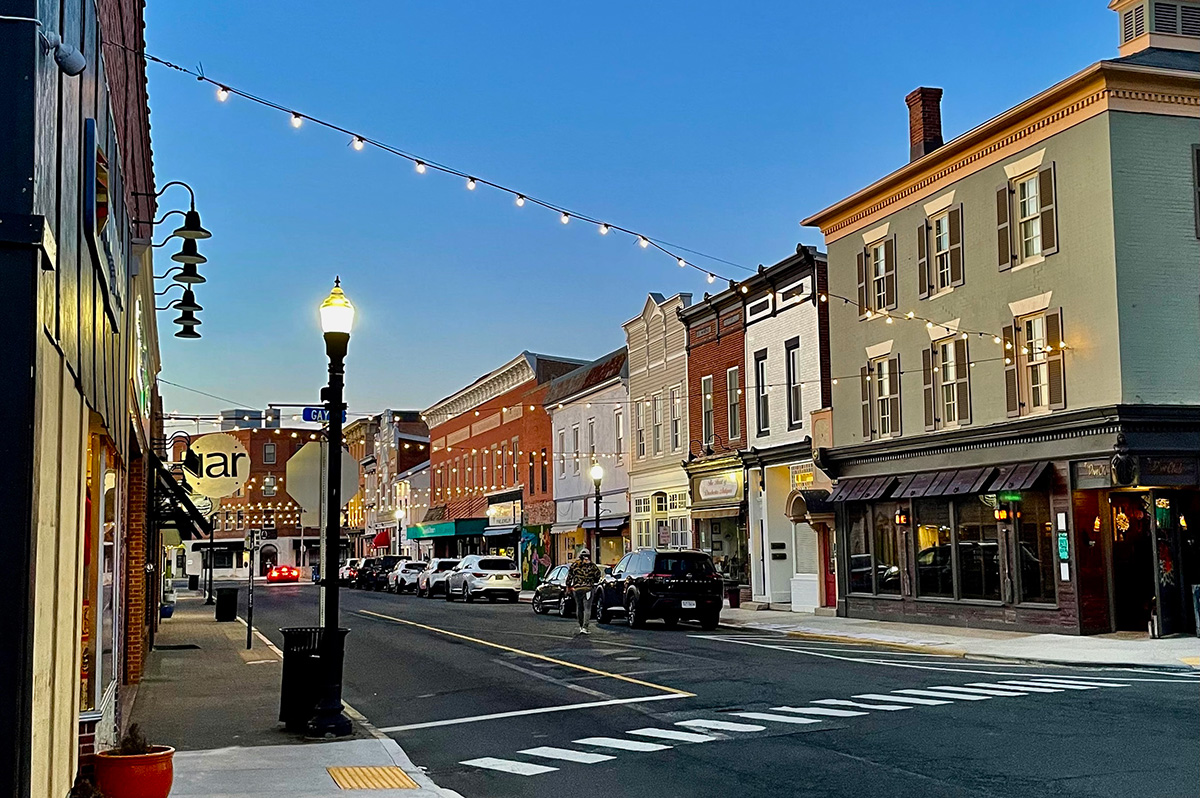
CAMBRIDGE, Md. — Driving through this scenic, historic town on Maryland’s Eastern Shore, you’ll be charmed by streets lined with unique shops, restaurants, and beautifully restored Victorian homes. You’ll also be struck by the number of LGBTQ Pride flags flying throughout the town.
The flags are a reassuring signal that everyone is welcome here, despite the town’s location in ruby red Dorchester County, which voted for Donald Trump over Kamala Harris by a lopsided margin. But don’t let that deter you from visiting. A new organization, Proudly Cambridge, is holding its debut Pride event this weekend, touting the town’s welcoming, inclusive culture.
“We stumbled on a beautiful secret and we wanted to help get the word out,” said James Lumalcuri of the effort to create Proudly Cambridge.
The organization celebrates diversity, enhances public spaces, and seeks to uplift all that Cambridge has to share, according to its mission statement, under the tagline “You Belong Here.”
The group has so far held informal movie nights and a picnic and garden party; the launch party is June 28 at the Cambridge Yacht Club, which will feature a Pride celebration and tea dance. The event’s 75 tickets sold out quickly and proceeds benefit DoCo Pride.
“Tickets went faster than we imagined and we’re bummed we can’t welcome everyone who wanted to come,” Lumalcuri said, adding that organizers plan to make “Cheers on the Choptank” an annual event with added capacity next year.
One of the group’s first projects was to distribute free Pride flags to anyone who requested one and the result is a visually striking display of a large number of flags flying all over town. Up next: Proudly Cambridge plans to roll out a program offering affirming businesses rainbow crab stickers to show their inclusiveness and LGBTQ support. The group also wants to engage with potential visitors and homebuyers.
“We want to spread the word outside of Cambridge — in D.C. and Baltimore — who don’t know about Cambridge,” Lumalcuri said. “We want them to come and know we are a safe haven. You can exist here and feel comfortable and supported by neighbors in a way that we didn’t anticipate when we moved here.”

Lumalcuri, 53, a federal government employee, and his husband, Lou Cardenas, 62, a Realtor, purchased a Victorian house in Cambridge in 2021 and embarked on an extensive renovation. The couple also owns a home in Adams Morgan in D.C.
“We saw the opportunity here and wanted to share it with others,” Cardenas said. “There’s lots of housing inventory in the $300-400,000 range … we’re not here to gentrify people out of town because a lot of these homes are just empty and need to be fixed up and we’re happy to be a part of that.”
Lumalcuri was talking with friends one Sunday last year at the gazebo (affectionately known as the “gayzebo” by locals) at the Yacht Club and the idea for Proudly Cambridge was born. The founding board members are Lumalcuri, Corey van Vlymen, Brian Orjuela, Lauren Mross, and Caleb Holland. The group is currently working toward forming a 501(c)3.
“We need visibility and support for those who need it,” Mross said. “We started making lists of what we wanted to do and the five of us ran with it. We started meeting weekly and solidified what we wanted to do.”
Mross, 50, a brand strategist and web designer, moved to Cambridge from Atlanta with her wife three years ago. They knew they wanted to be near the water and farther north and began researching their options when they discovered Cambridge.
“I had not heard of Cambridge but the location seemed perfect,” she said. “I pointed on a map and said this is where we’re going to move.”
The couple packed up, bought a camper trailer and parked it in different campsites but kept coming back to Cambridge.
“I didn’t know how right it was until we moved here,” she said. “It’s the most welcoming place … there’s an energy vortex here – how did so many cool, progressive people end up in one place?”
Corey van Vlymen and his husband live in D.C. and were looking for a second home. They considered Lost River, W.Va., but decided they preferred to be on the water.
“We looked at a map on both sides of the bay and came to Cambridge on a Saturday and bought a house that day,” said van Vlymen, 39, a senior scientist at Booz Allen Hamilton. They’ve owned in Cambridge for two years.
They were drawn to Cambridge due to its location on the water, the affordable housing inventory, and its proximity to D.C.; it’s about an hour and 20 minutes away.
Now, through the work of Proudly Cambridge, they hope to highlight the town’s many attributes to residents and visitors alike.
“Something we all agree on is there’s a perception problem for Cambridge and a lack of awareness,” van Vlymen said. “If you tell someone you’re going to Cambridge, chances are they think, ‘England or Massachusetts?’”
He cited the affordability and the opportunity to save older, historic homes as a big draw for buyers.
“It’s all about celebrating all the things that make Cambridge great,” Mross added. “Our monthly social events are joyful and celebratory.” A recent game night drew about 70 people.
She noted that the goal is not to gentrify the town and push longtime residents out, but to uplift all the people who are already there while welcoming new visitors and future residents.
They also noted that Proudly Cambridge does not seek to supplant existing Pride-focused organizations. Dorchester County Pride organizes countywide Pride events and Delmarva Pride was held in nearby Easton two weeks ago.
“We celebrate all diversity but are gay powered and gay led,” Mross noted.
To learn more about Proudly Cambridge, visit the group on Facebook and Instagram.
What to see and do
Cambridge, located 13 miles up the Choptank River from the Chesapeake Bay, has a population of roughly 15,000. It was settled in 1684 and named for the English university town in 1686. It is home to the Harriet Tubman Museum, mural, and monument. Its proximity to the Blackwater National Wildlife Refuge makes it a popular stop for birders, drawn to more than 27,000 acres of marshland dubbed “the Everglades of the north.”
The refuge is walkable, bikeable, and driveable, making it an accessible attraction for all. There are kayaking and biking tours through Blackwater Adventures (blackwateradventuresmd.com).
Back in town, take a stroll along the water and through historic downtown and admire the architecture. Take in the striking Harriet Tubman mural (424 Race St.). Shop in the many local boutiques, and don’t miss the gay-owned Shorelife Home and Gifts (421 Race St.), filled with stylish coastal décor items.
Stop for breakfast or lunch at Black Water Bakery (429 Race St.), which offers a full compliment of coffee drinks along with a build-your-own mimosa bar and a full menu of creative cocktails.
The Cambridge Yacht Club (1 Mill St.) is always bustling but you need to be a member to get in. Snapper’s on the water is temporarily closed for renovations. RaR Brewing (rarbrewing.com) is popular for craft beers served in an 80-year-old former pool hall and bowling alley. The menu offers burgers, wings, and other bar fare.
For dinner or wine, don’t miss the fantastic Vintage 414 (414 Race St.), which offers lunch, dinner, wine tasting events, specialty foods, and a large selection of wines. The homemade cheddar crackers, inventive flatbreads, and creative desserts (citrus olive oil cake, carrot cake trifle) were a hit on a recent visit.
Also nearby is Ava’s (305 High St.), a regional chain offering outstanding Italian dishes, pizzas, and more.
For something off the beaten path, visit Emily’s Produce (22143 Church Creek Rd.) for its nursery, produce, and prepared meals.
“Ten minutes into the sticks there’s a place called Emily’s Produce, where you can pay $5 and walk through a field and pick sunflowers, blueberries, you can feed the goats … and they have great food,” van Vlymen said.
As for accommodations, there’s the Hyatt Regency Chesapeake Bay (100 Heron Blvd. at Route 50), a resort complex with golf course, spa, and marina. Otherwise, check out Airbnb and VRBO for short-term rentals closer to downtown.
Its proximity to D.C. and Baltimore makes Cambridge an ideal weekend getaway. The large LGBTQ population is welcoming and they are happy to talk up their town and show you around.
“There’s a closeness among the neighbors that I wasn’t feeling in D.C.,” Lumalcuri said. “We look after each other.”
a&e features
James Baldwin bio shows how much of his life is revealed in his work
‘A Love Story’ is first major book on acclaimed author’s life in 30 years

‘Baldwin: A Love Story’
By Nicholas Boggs
c.2025, FSG
$35/704 pages
“Baldwin: A Love Story” is a sympathetic biography, the first major one in 30 years, of acclaimed Black gay writer James Baldwin. Drawing on Baldwin’s fiction, essays, and letters, Nicolas Boggs, a white writer who rediscovered and co-edited a new edition of a long-lost Baldwin book, explores Baldwin’s life and work through focusing on his lovers, mentors, and inspirations.
The book begins with a quick look at Baldwin’s childhood in Harlem, and his difficult relationship with his religious, angry stepfather. Baldwin’s experience with Orilla Miller, a white teacher who encouraged the boy’s writing and took him to plays and movies, even against his father’s wishes, helped shape his life and tempered his feelings toward white people. When Baldwin later joined a church and became a child preacher, though, he felt conflicted between academic success and religious demands, even denouncing Miller at one point. In a fascinating late essay, Baldwin also described his teenage sexual relationship with a mobster, who showed him off in public.
Baldwin’s romantic life was complicated, as he preferred men who were not outwardly gay. Indeed, many would marry women and have children while also involved with Baldwin. Still, they would often remain friends and enabled Baldwin’s work. Lucien Happersberger, who met Baldwin while both were living in Paris, sent him to a Swiss village, where he wrote his first novel, “Go Tell It on the Mountain,” as well as an essay, “Stranger in the Village,” about the oddness of being the first Black person many villagers had ever seen. Baldwin met Turkish actor Engin Cezzar in New York at the Actors’ Studio; Baldwin later spent time in Istanbul with Cezzar and his wife, finishing “Another Country” and directing a controversial play about Turkish prisoners that depicted sexuality and gender.
Baldwin collaborated with French artist Yoran Cazac on a children’s book, which later vanished. Boggs writes of his excitement about coming across this book while a student at Yale and how he later interviewed Cazac and his wife while also republishing the book. Baldwin also had many tumultuous sexual relationships with young men whom he tried to mentor and shape, most of which led to drama and despair.
The book carefully examines Baldwin’s development as a writer. “Go Tell It on the Mountain” draws heavily on his early life, giving subtle signs of the main character John’s sexuality, while “Giovanni’s Room” bravely and openly shows a homosexual relationship, highly controversial at the time. “If Beale Street Could Talk” features a woman as its main character and narrator, the first time Baldwin wrote fully through a woman’s perspective. His essays feel deeply personal, even if they do not reveal everything; Lucian is the unnamed visiting friend in one who the police briefly detained along with Baldwin. He found New York too distracting to write, spending his time there with friends and family or on business. He was close friends with modernist painter Beauford Delaney, also gay, who helped Baldwin see that a Black man could thrive as an artist. Delaney would later move to France, staying near Baldwin’s home.
An epilogue has Boggs writing about encountering Baldwin’s work as one of the few white students in a majority-Black school. It helpfully reminds us that Baldwin connects to all who feel different, no matter their race, sexuality, gender, or class. A well-written, easy-flowing biography, with many excerpts from Baldwin’s writing, it shows how much of his life is revealed in his work. Let’s hope it encourages reading the work, either again or for the first time.
a&e features
Looking back at 50 years of Pride in D.C
Washington Blade’s unique archives chronicle highs, lows of our movement
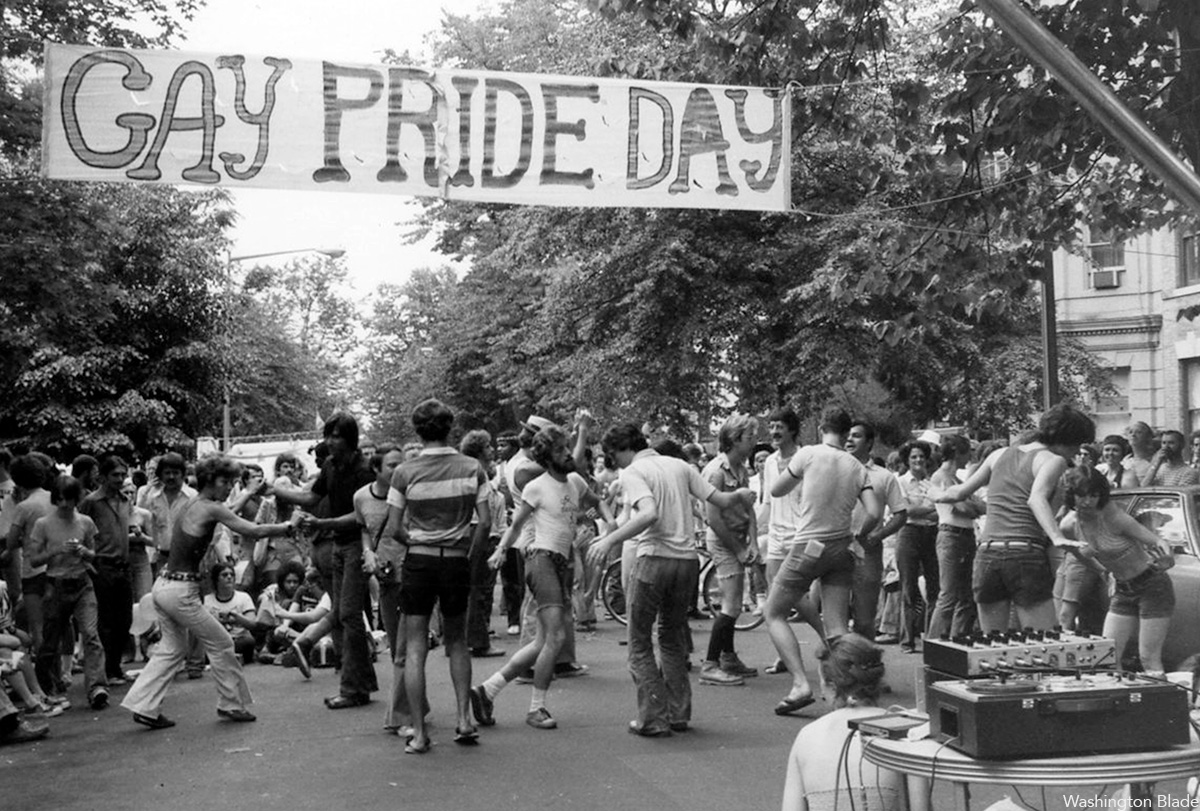
To celebrate the 50th anniversary of LGBTQ Pride in Washington, D.C., the Washington Blade team combed our archives and put together a glossy magazine showcasing five decades of celebrations in the city. Below is a sampling of images from the magazine but be sure to find a print copy starting this week.
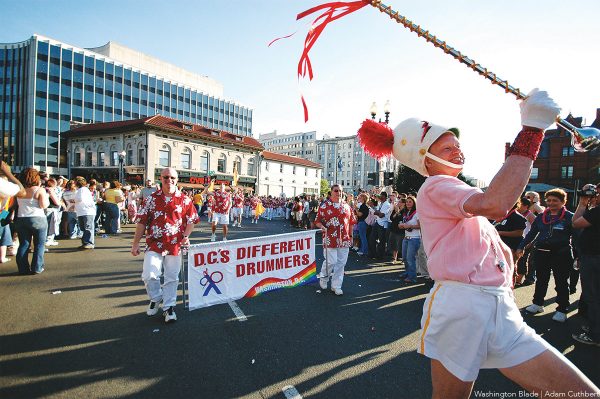
The magazine is being distributed now and is complimentary. You can find copies at LGBTQ bars and restaurants across the city. Or visit the Blade booth at the Pride festival on June 7 and 8 where we will distribute copies.
Thank you to our advertisers and sponsors, whose support has enabled us to distribute the magazine free of charge. And thanks to our dedicated team at the Blade, especially Photo Editor Michael Key, who spent many hours searching the archives for the best images, many of which are unique to the Blade and cannot be found elsewhere. And thanks to our dynamic production team of Meaghan Juba, who designed the magazine, and Phil Rockstroh who managed the process. Stephen Rutgers and Brian Pitts handled sales and marketing and staff writers Lou Chibbaro Jr., Christopher Kane, Michael K. Lavers, Joe Reberkenny along with freelancer and former Blade staffer Joey DiGuglielmo wrote the essays.

The magazine represents more than 50 years of hard work by countless reporters, editors, advertising sales reps, photographers, and other media professionals who have brought you the Washington Blade since 1969.
We hope you enjoy the magazine and keep it as a reminder of all the many ups and downs our local LGBTQ community has experienced over the past 50 years.
I hope you will consider supporting our vital mission by becoming a Blade member today. At a time when reliable, accurate LGBTQ news is more essential than ever, your contribution helps make it possible. With a monthly gift starting at just $7, you’ll ensure that the Blade remains a trusted, free resource for the community — now and for years to come. Click here to help fund LGBTQ journalism.
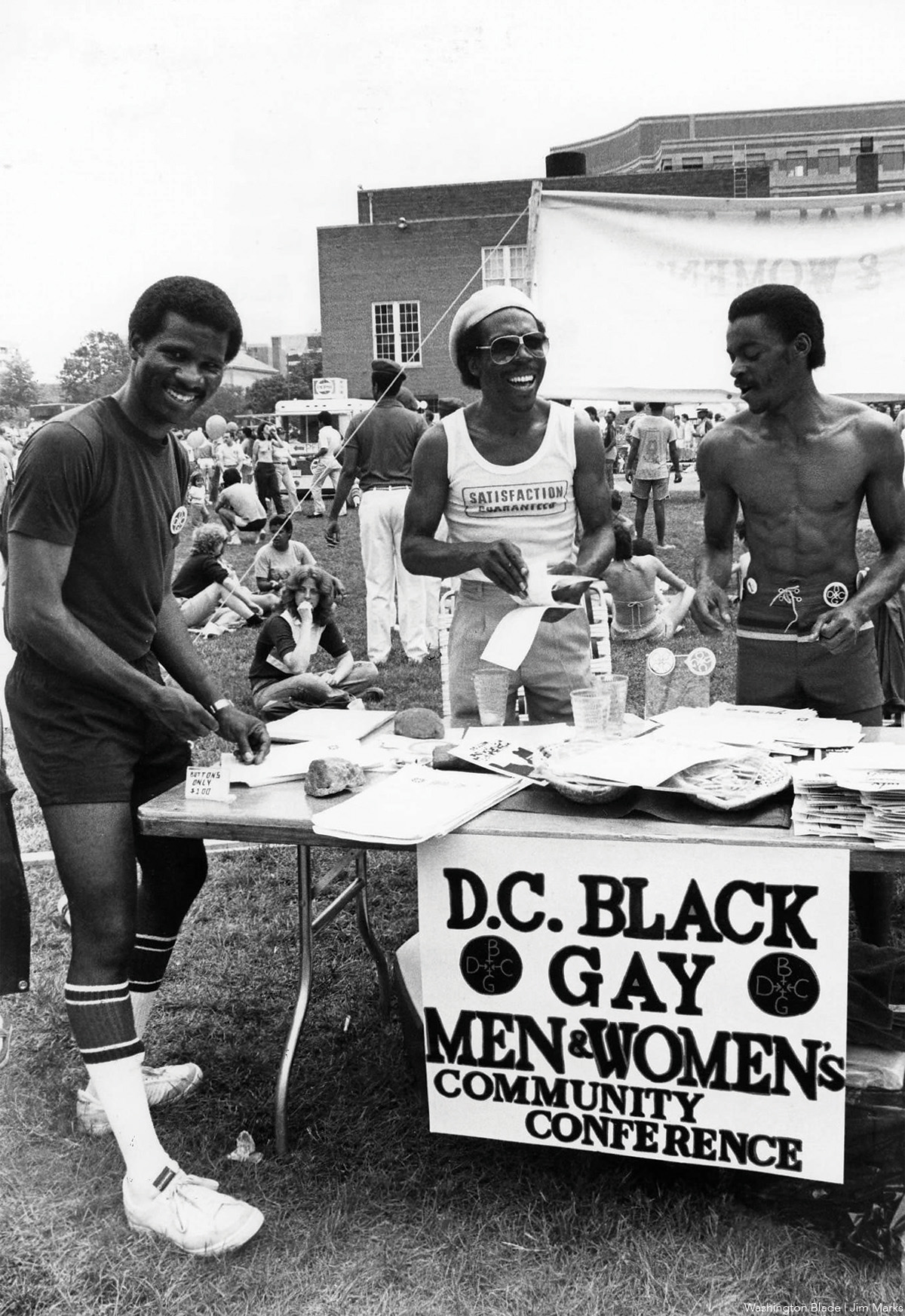
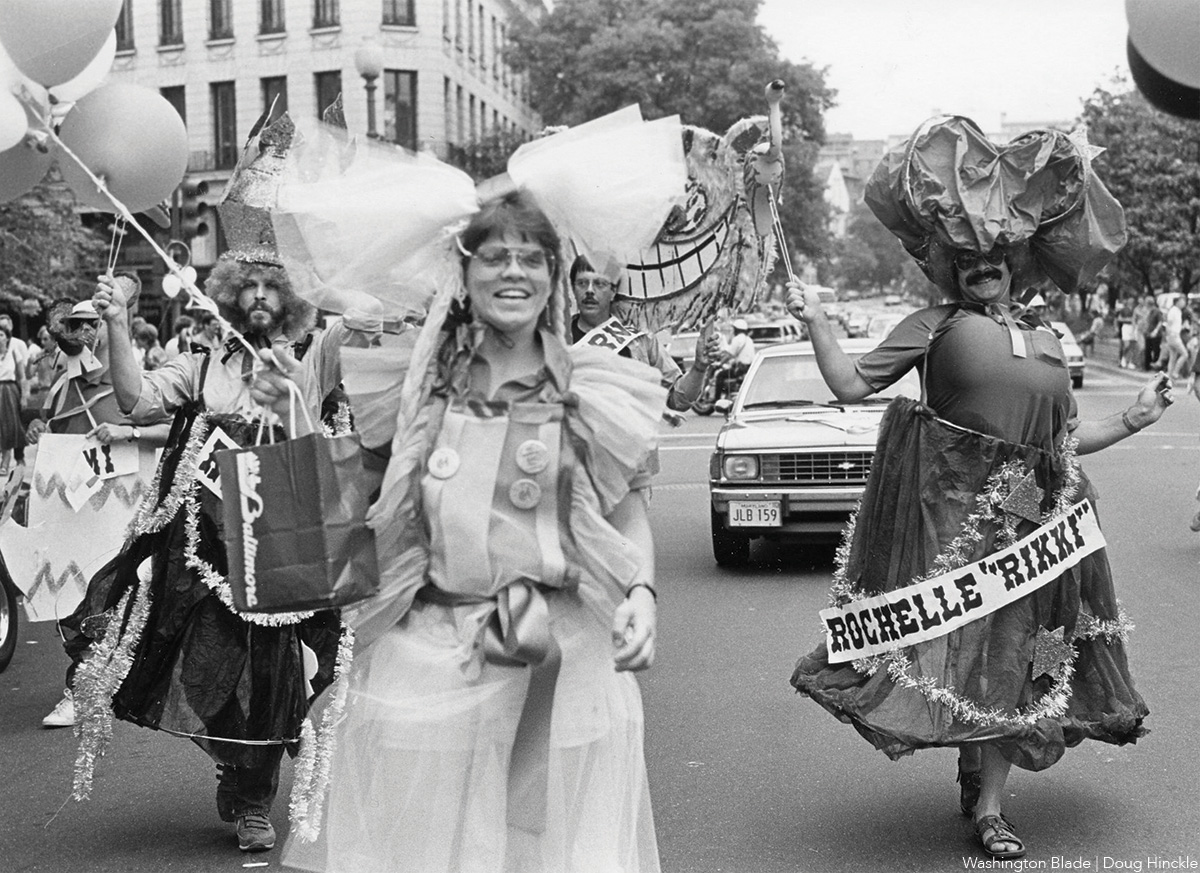
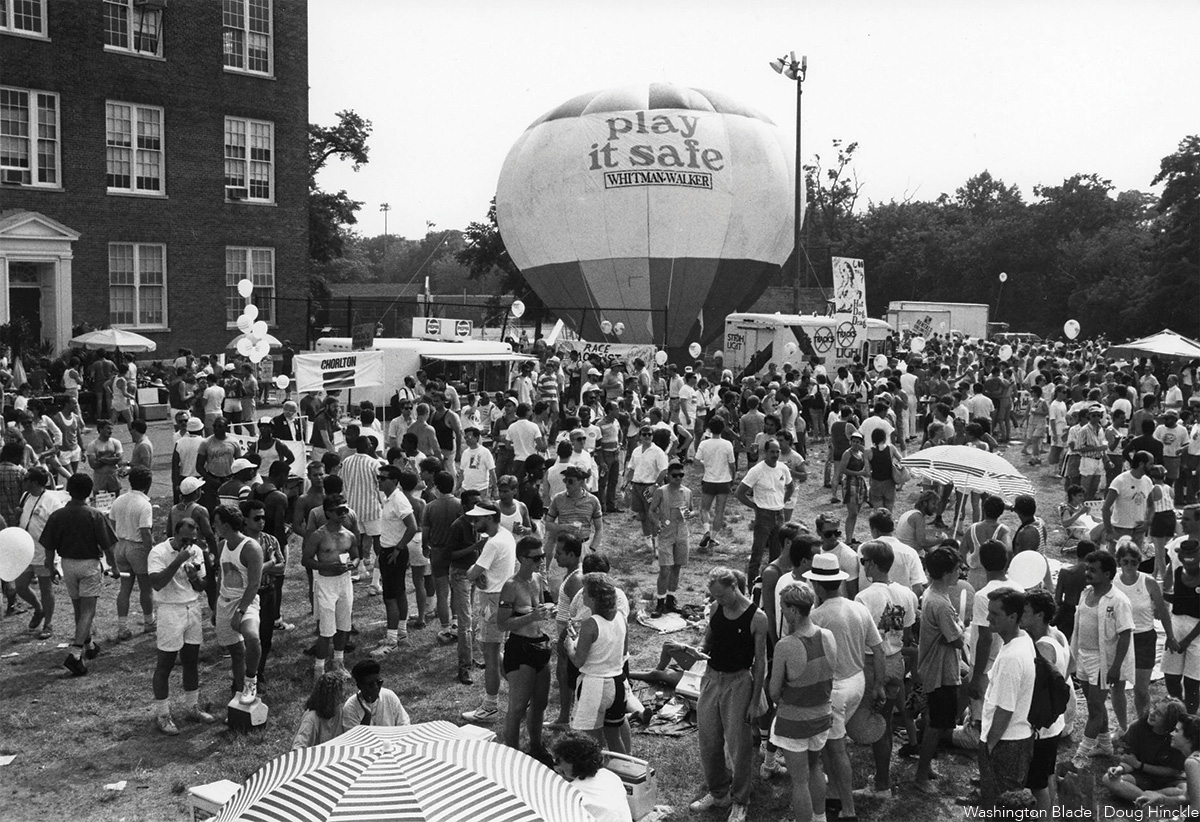
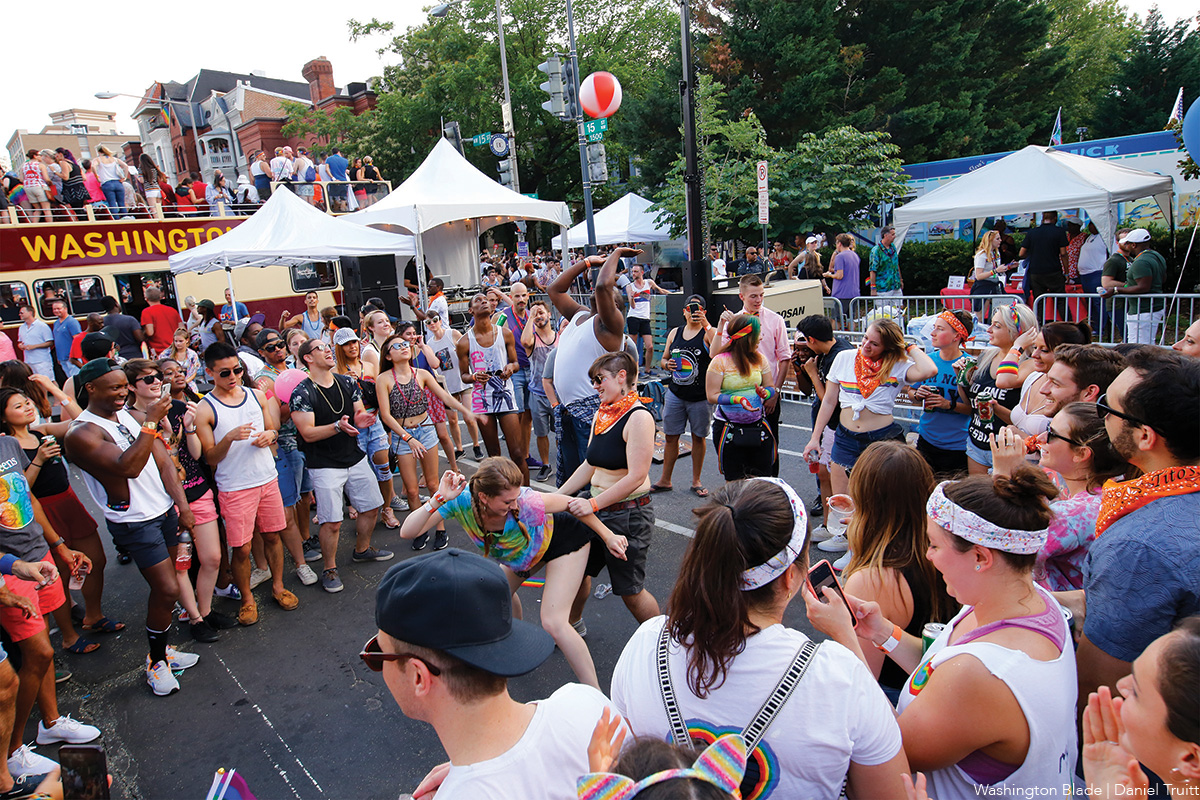
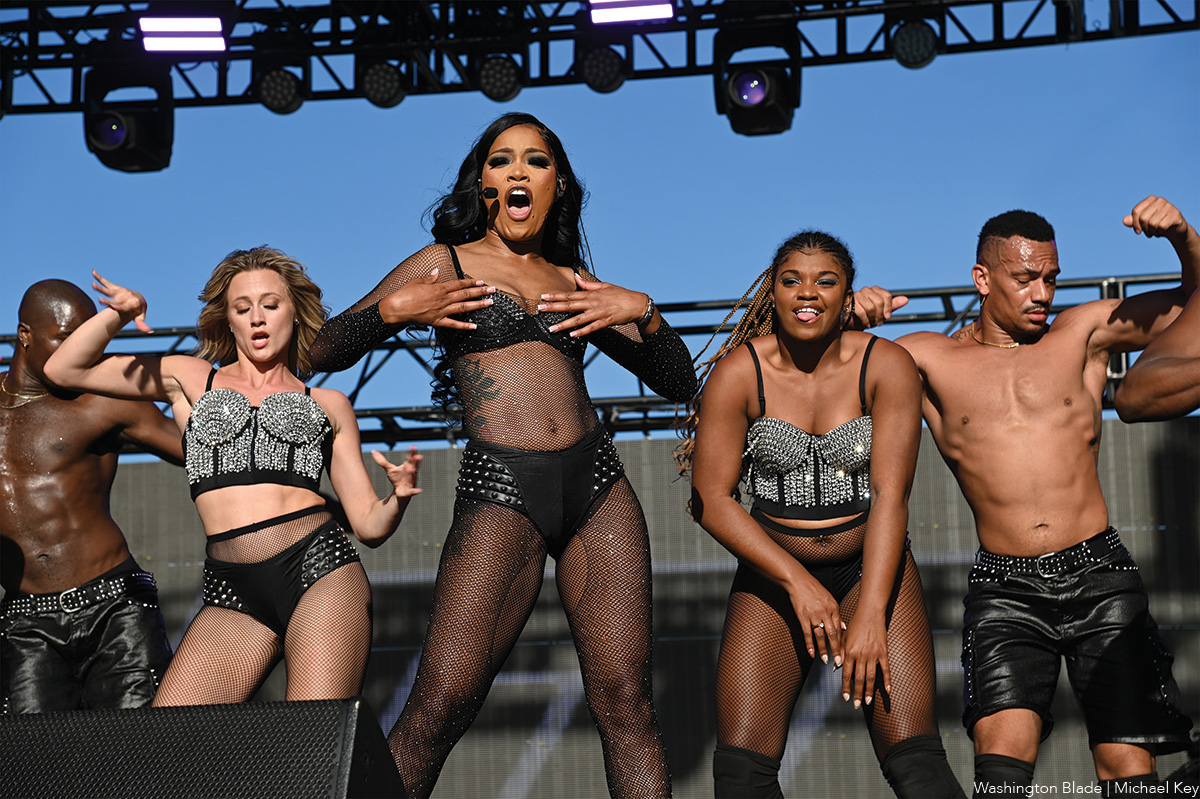
-

 U.S. Supreme Court4 days ago
U.S. Supreme Court4 days agoSupreme Court upholds ACA rule that makes PrEP, other preventative care free
-

 U.S. Supreme Court4 days ago
U.S. Supreme Court4 days agoSupreme Court rules parents must have option to opt children out of LGBTQ-specific lessons
-
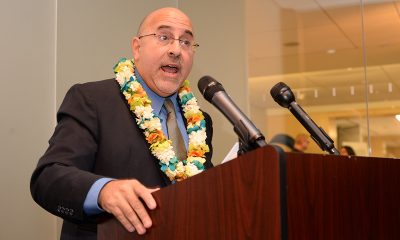
 National5 days ago
National5 days agoEvan Wolfson on the 10-year legacy of marriage equality
-

 Congress5 days ago
Congress5 days agoSenate parliamentarian orders removal of gender-affirming care ban from GOP reconciliation bill











